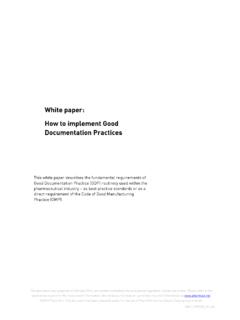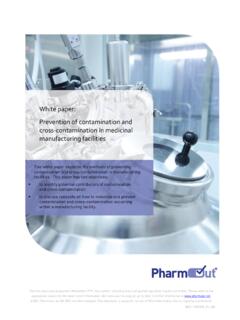Transcription of The 10 Golden Rules of GMP - PharmOut
1 White paper: The 10 Golden Rules of GMP. The good manufacturing Practice regulations that govern pharmaceutical and medical device manufacturing can seem overwhelming. Use these ten Golden Rules to drive your day-to-day operations, keeping them in mind whenever you make decisions that have GMP implications. This white paper is an ideal refresher for the experienced GMP professional or great training material for the newbie. This document was prepared in February 2016, any content including links and quoted regulation may be out of date. Please refer to the appropriate source for the most recent information. We endeavour to keep an up-to-date record of information at 2016 PharmOut . This document has been prepared solely for the use of PharmOut and its clients.
2 Copying is prohibited. MKT_TMP200_01_r06. PharmOut white paper: The 10 Golden Rules of GMP. What are the 10 Golden Rules ? Golden Rule#1 Get the facility design right from the start Golden Rule#2 Validate processes Golden Rule#3 Write good procedures and follow them Golden Rule#4 Identify who does what Golden Rule#5 Keep good records Golden Rule#6 Train and develop staff Golden Rule#7 Practice good hygiene Golden Rule#8 Maintain facilities and equipment Golden Rule#9 Build quality into the whole product lifecycle Golden Rule#10 Perform regular audits PharmOut Pty Ltd, ABN: 85 117 673 766, Unit 10, 24 Lakeside Drive, Burwood East, Victoria 3151. Ph: +61 3 9887 6412, Fax: +61 3 8610 0169, Email: Web: 2016 PharmOut . This document has been prepared solely for the use of PharmOut and its clients.
3 Copying is prohibited. Page 2 of 19 MKT_TMP200_01_r06. PharmOut white paper: The 10 Golden Rules of GMP. Golden Rule #1. Get the facility design right form the start Every food, drug, and medical device manufacturer aims to operate their business in accordance with the principles of good manufacturing Practice (GMP). It's much easier to be GMP compliant if the design and construction of the facilities and equipment are right from the start. It's important to embody GMP principles and use GMP to drive every decision. Sometimes you need to step back and reconsider the whole production area'. Facility layout Lay out the production area to suit the sequence of operations. The aim is to reduce the chances of cross contamination and to avoid mix-ups and errors.
4 For example, don't have final product passing through or near areas that contain intermediate products or raw materials. A logical and well-planned layout will improve productivity. Sometimes you need to step back and reconsider the whole production area rather than applying quick fix solutions. Aim to: remove unnecessary traffic in the production area which could result in a hazardous environment segregate materials, products, and their components to minimise confusion and potential for mix-ups and errors. Example A company, through poor planning, failed to keep the product manufacturing process linear. As the product moved through the factory, it was zigzagged from one area to another. This meant that near-final product was exposed to early-stage product with the potential of contamination.
5 Before making any changes, the company should have stepped back and reviewed the layout as a whole. PharmOut Pty Ltd, ABN: 85 117 673 766, Unit 10, 24 Lakeside Drive, Burwood East, Victoria 3151. Ph: +61 3 9887 6412, Fax: +61 3 8610 0169, Email: Web: 2016 PharmOut . This document has been prepared solely for the use of PharmOut and its clients. Copying is prohibited. Page 3 of 19 MKT_TMP200_01_r06. PharmOut white paper: The 10 Golden Rules of GMP. Environment It's important to control the air, water, lighting, ventilation, temperature, and humidity within a plant so that it does not impact product quality. You should design facilities to reduce the risk of contamination from the environment. Make sure that: lighting, temperature, humidity and ventilation are appropriate interior surfaces (walls, floors and ceilings) are smooth, free from cracks and do not shed particulate matter interior surfaces are easy to clean pipe work, light fittings, and ventilation points are easy to clean drains are sized adequately and have trapped gullies.
6 Equipment Design, locate, and maintain equipment to suit its intended use. Make sure that equipment is: easy to repair and maintain designed and installed in an area where it can be easily cleaned suitable for its intended use not reactive, additive or absorptive calibrated at defined intervals (if necessary). clearly labelled. PharmOut Pty Ltd, ABN: 85 117 673 766, Unit 10, 24 Lakeside Drive, Burwood East, Victoria 3151. Ph: +61 3 9887 6412, Fax: +61 3 8610 0169, Email: Web: 2016 PharmOut . This document has been prepared solely for the use of PharmOut and its clients. Copying is prohibited. Page 4 of 19 MKT_TMP200_01_r06. PharmOut white paper: The 10 Golden Rules of GMP. Golden Rule #2. Validate processes It's one thing to design and construct state of the art facilities and equipment, but how do you ensure that it's operated in a controlled manner?
7 This is where validation comes into play. To prove that equipment and processes consistently do what they are supposed to do, testing and documentation is required. Consistent performance is the key to maintaining safety and effectiveness of every product and enhances a company's reputation for quality and reliability. Validation By definition, validation is: "Establishing documented evidence that provides a high degree of assurance that a specific process will consistently produce a product meeting its pre-determined specifications and quality attributes.". It's a GMP requirement to prove control of the critical aspects of certain operations. New facilities and equipment, as well as significant changes to existing systems, require validation. All validation activities should be well planned and clearly defined.
8 This is usually by means of a Validation Master Plan, or VMP. Before you get to this stage consider all the critical parameters that may be affected and impact product quality; what happens if the stirring speed is changed? How does this affect temperature or pH? Once this is complete, define the testing and documentation required. Validation usually involves: Installation Qualification, or IQ, which is testing to verify that the equipment is installed correctly Operational Qualification, or OQ, which is testing to verify that the equipment operates correctly Performance Qualification, or PQ, which is testing to verify that product can be consistently be produced to specification. A protocol describing each test and the acceptance criteria should be prepared, and once the testing is complete, a report written.
9 Change control Once testing is complete and the equipment or process is known to be controlled, it's important to maintain its validated state'. Achieve this by correctly following written procedures, and properly maintaining and calibrating equipment. If a change to the validated state is required then it must be subject to change control. A change control system should be in place to document all changes to facilities, equipment, or processes that may have an impact on product quality. You should evaluate the impact of the change and define the extent of re-validation. PharmOut Pty Ltd, ABN: 85 117 673 766, Unit 10, 24 Lakeside Drive, Burwood East, Victoria 3151. Ph: +61 3 9887 6412, Fax: +61 3 8610 0169, Email: Web: 2016 PharmOut . This document has been prepared solely for the use of PharmOut and its clients.
10 Copying is prohibited. Page 5 of 19 MKT_TMP200_01_r06. PharmOut white paper: The 10 Golden Rules of GMP. Example A computer system was validated after it was first installed on site. Some years later an auditor discovered that changes had been made to the system. No re-validation work had been performed and the system was no longer in its validated state. How did the company know that the system was operating in a controlled and consistent manner? The answer is they didn't. The oversight was due to a weak change control system that allowed changes to be made without formal evaluation and re-validation. Golden Rule #3. Write good procedure and follow them Think about what happens in a workplace if written procedures are not available. People rely on longer-term employees to tell them how to do things and then do their job from memory.










